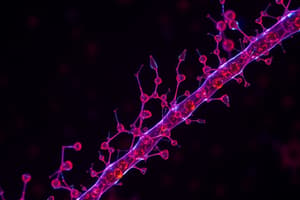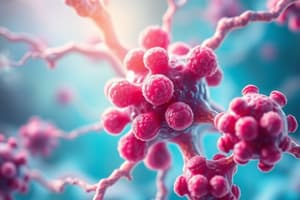Podcast
Questions and Answers
What is the fundamental unit of life that carries out all vital functions?
What is the fundamental unit of life that carries out all vital functions?
- Cell (correct)
- Atom
- Tissue
- Organ
Which level of biological organization includes groups of individuals of the same species in a given area?
Which level of biological organization includes groups of individuals of the same species in a given area?
- Community
- Organism
- Ecosystem
- Population (correct)
What term describes the variety of life on Earth, including the diversity of genetic material, species, and ecosystems?
What term describes the variety of life on Earth, including the diversity of genetic material, species, and ecosystems?
- Biodiversity (correct)
- Ecology
- Phylogeny
- Taxonomy
In ecology, what is primarily studied under human impact?
In ecology, what is primarily studied under human impact?
Which area of physiology deals with the regulation of internal environments in animals?
Which area of physiology deals with the regulation of internal environments in animals?
What scientific approach involves manipulating organisms for practical applications, such as genetic engineering?
What scientific approach involves manipulating organisms for practical applications, such as genetic engineering?
Which term refers to the evolutionary relationships among organisms?
Which term refers to the evolutionary relationships among organisms?
What does homeostasis refer to in biological organisms?
What does homeostasis refer to in biological organisms?
Which statement best describes the cellular basis of life?
Which statement best describes the cellular basis of life?
What is the primary role of DNA in living organisms?
What is the primary role of DNA in living organisms?
Which concept explains how organisms adapt to their environment over time?
Which concept explains how organisms adapt to their environment over time?
How do living organisms primarily obtain energy?
How do living organisms primarily obtain energy?
What does the term 'homeostasis' refer to in biological systems?
What does the term 'homeostasis' refer to in biological systems?
What is the significance of Mendelian genetics?
What is the significance of Mendelian genetics?
Which process is involved in synthesizing proteins from genes?
Which process is involved in synthesizing proteins from genes?
Which of the following best illustrates the relationship between structure and function in biology?
Which of the following best illustrates the relationship between structure and function in biology?
Flashcards
Community Ecology
Community Ecology
The scientific study of interactions between different species in a given area, including concepts like competition, predation, and symbiosis.
What is a cell?
What is a cell?
The smallest unit of life, responsible for all life functions.
Ecosystem Ecology
Ecosystem Ecology
The branch of biology that studies the flow of energy and cycling of nutrients within an ecosystem.
What is homeostasis?
What is homeostasis?
Signup and view all the flashcards
Cellular Physiology
Cellular Physiology
Signup and view all the flashcards
What is genetics?
What is genetics?
Signup and view all the flashcards
Taxonomy
Taxonomy
Signup and view all the flashcards
What is DNA?
What is DNA?
Signup and view all the flashcards
What is a gene?
What is a gene?
Signup and view all the flashcards
Homeostasis
Homeostasis
Signup and view all the flashcards
Species
Species
Signup and view all the flashcards
What is evolution?
What is evolution?
Signup and view all the flashcards
Biotechnology
Biotechnology
Signup and view all the flashcards
What is reproduction?
What is reproduction?
Signup and view all the flashcards
What is DNA replication?
What is DNA replication?
Signup and view all the flashcards
Conservation Biology
Conservation Biology
Signup and view all the flashcards
Study Notes
Introduction to Biology
- Biology is the scientific study of life and living organisms.
- It encompasses a vast range of topics, from the molecular level of cells to the ecosystems of entire planets.
- Biology is a multidisciplinary science, drawing on principles from physics, chemistry, and other fields.
- Branches of biology include: genetics, ecology, physiology, zoology, botany, etc.
Key Concepts in Biology
- Cellular Basis of Life: All living organisms are composed of cells. Cells are the fundamental units of life and perform all life processes.
- Molecular Basis of Life: Biological molecules (carbohydrates, lipids, proteins, and nucleic acids) are essential for life. DNA, the genetic material, carries the instructions for building and maintaining an organism.
- Evolution: Life on Earth has evolved over billions of years through a process of natural selection. Organisms with traits that enhance their survival and reproduction are more likely to pass these traits to future generations.
- Structure and Function: The structure of biological components (e.g., organs, tissues, cells) correlates with their function. A precise structure supports the specific task.
- Energy and Metabolism: Living things need energy to function. Organisms obtain and use energy through processes like photosynthesis (in plants), respiration (in animals), and chemosynthesis.
- Homeostasis: Organisms maintain a stable internal environment, or homeostasis. This regulation plays a vital role in survival, and includes temperature, pH, and other factors.
- Interactions: Living organisms are not isolated; they interact with each other and their environment.
- Reproduction: Organisms reproduce to create new organisms of the same kind. Mechanisms of reproduction vary greatly across species.
- Inheritance: Traits are passed from parents to offspring through genetic material.
Principles of Genetics
- DNA Structure and Replication: Deoxyribonucleic acid (DNA) is a double helix structure carrying genetic information. DNA replication is crucial for cell division and reproduction.
- Gene Expression: Genes are segments of DNA that code for specific proteins. Transcription and translation are processes by which information in genes is used to synthesize proteins.
- Mendelian Genetics: Gregor Mendel's work established the basic principles of heredity, such as dominant and recessive traits.
- Modern Genetics: Understanding of genetics has expanded significantly in the 20th and 21st centuries, including advancements in gene editing and genetic mapping.
Levels of Biological Organization
- Atoms and Molecules - Basic building blocks, chemical elements combine
- Cells - Fundamental units
- Tissues - Groups of similar cells
- Organs - Structures consisting of different tissues
- Organ Systems - Groups of organs performing a specific function
- Organisms - Individual living entities
- Populations - Groups of individuals of the same species in a given area
- Communities - All living organisms in a particular area
- Ecosystems - Biotic and abiotic components of a region
- Biosphere - The global sum of all ecosystems
Ecology
- Populations: Study of populations: size, distribution, growth, and factors affecting these.
- Communities: Interactions between different species in a given area; competition, predation, symbiosis, and mutualism.
- Ecosystems: Flow of energy and cycling of nutrients within an ecosystem. This includes understanding the impact of human activity on ecosystems.
- Biodiversity: The variety of life on Earth, including the diversity of genetic material, species, and ecosystems.
- Environmental Factors: The role of environmental factors like temperature, water, and light on species distribution and interaction.
Physiology
- Cellular Physiology: Study of how cells function at the molecular and cellular levels.
- Organ Physiology: Study of how different organs and organ systems work.
- Animal Physiology: Study of how animals regulate their internal environments and respond to external stimuli.
- Plant physiology: Study of how plants function.
- Homeostasis: regulation of internal environment to maintain stability, crucial for survival and function of living organisms.
Biological Diversity
- Taxonomy: The science of classifying, identifying and naming organisms using a standardized system.
- Phylogeny: The evolutionary relationships among organisms; understanding common ancestry via branching patterns of evolutionary relationships.
- Species: A group of organisms that can interbreed and produce fertile offspring. Species definitions can be complex.
Modern Applications of Biology
- Biotechnology: Manipulating organisms or their components for practical purposes such as genetic engineering, bioremediation, and pharmaceutical production.
- Medicine and Healthcare: Understanding disease mechanisms, developing treatments, and advancing healthcare technology, like personalized medicine.
- Conservation Biology: Protecting endangered species and conserving biodiversity, crucial in addressing current environmental challenges.
- Agriculture: Improving crop yields, developing pest-resistant crops, and promoting sustainable agriculture.
- Environmental Science: Understanding environmental issues and developing solutions for sustainability, including pollution control and resource management.
Studying That Suits You
Use AI to generate personalized quizzes and flashcards to suit your learning preferences.




